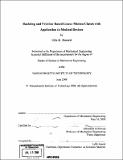Buckling and friction-based linear motion clutch with application to medical devices
Author(s)
Bassett, Erik K
DownloadFull printable version (45.39Mb)
Other Contributors
Massachusetts Institute of Technology. Dept. of Mechanical Engineering.
Advisor
Alexander H. Slocum.
Terms of use
Metadata
Show full item recordAbstract
Improperly inserted and positioned needles and catheters often require repeated attempts at correct placement causing injury to adjacent structures or infusions into inappropriate spaces. Existing catheter insertion methods do not uniformly provide needle tip location feedback, nor prevent the needle from going beyond the target space. This research achieved the development of design methods and analysis tools that can be used to create a new catheter insertion device. This device can advance a needle through firm tissue but automatically stop advancing it upon entrance into a target space. Prototypes of the device were tested on raw chicken breast, the best of which had about a 50% success rate. Tests performed on deceased pigs showed the device advanced well through muscle but not the peritoneum. The system studied consisted of a flexible filament (OD ~0.9 mm) passing through a tube (ID ~1.2 mm) with both straight and curved sections. Initially it was believed that the capstan equation would provide a good model for the system in tension and compression. Though the capstan equation proved valid for the system under tension, models from drill strings used in the petroleum industry provided an accurate model for the system in compression. Based on the geometry of the tube, this model accurately predicts the compressive force in the filament and when the filament locks-up inside the tube (needle). An alternate method to measure the tube geometry using a flatbed scanner was developed and studied. This method was found to provide excellent accuracy and repeatability for measuring tubes, and has shown potential as a measurement method for many other applications.
Description
Thesis (S.M.)--Massachusetts Institute of Technology, Dept. of Mechanical Engineering, 2008. Includes bibliographical references (p. 158).
Date issued
2008Department
Massachusetts Institute of Technology. Department of Mechanical EngineeringPublisher
Massachusetts Institute of Technology
Keywords
Mechanical Engineering.